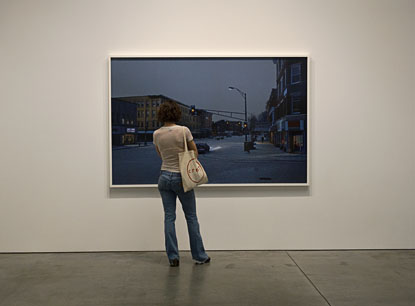
"Woman at Gregory Crewdson show," Tim Connor, All rights reserved
For years I've been making references to Gregory Crewdson's work based solely on what I've seen & read in books or online. This didn't seem right, so 2 weeks ago I went to look at his "Beneath the Roses" show at Luhring Augustine (sorry, the show is now closed).
A critically & commercially successful artist & influential teacher at Yale, Crewdson is an originator of the large-format, total-control style that continues to dominate contemporary art photography. Most of the time setting out to tell stories in a single frame, his methods are famously cinematic. He rents locations & hires large crews for weeks at a time, builds, demolishes, sometimes burns sets, uses truckloads of lighting equipment, fog & snowmaking machinery, etc. Though he works with a set designer & crew, a lighting director, even a director of photography, Crewdson is said to remain in complete artistic control of every detail of his pictures.
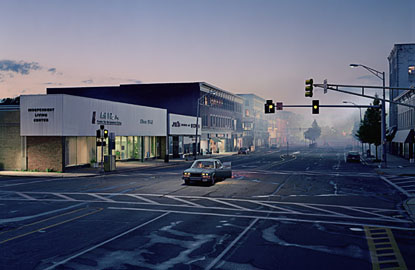
Gregory Crewdson, All rights reserved
Crewdson's stories are open-ended, often melodramatic, with a tendency toward wistful melancholy. Take the picture above. In the deserted downtown of a small New England city, dawn is burning away the night mist. A car is stopped at a stoplight. The driver's door is wide open, but the driver is nowhere to be seen. The passenger, a woman, sits stiffly in the car, staring straight ahead. What has happened? Was it a lover's quarrel? A family fight? Was a crime committed? The car's headlights are on. All the shops are still closed up tight. Soon the stoplight will change from yellow to red. The 1st early risers will begin to appear on the streets. Where is the driver? We don't know. Why, we ask ourself, doesn't the woman at least shut the door?
Crewdson's genius is to create a richly specific, lavishly detailed world where he doesn't have to answer those questions. By sifting visual clues, it's up to the viewer to answer them. In a movie, Crewdson would have to do more. Even if past or future are not revealed, a movie is responsible for them. Cinema is all about time. Crewdson's pictures, on the other hand -- though bursting with associations to the world outside the frame -- are frozen in an eternal stasis. Like movies at their best, they enable rapturous time-and-space travel to a real (made up) place; but, unlike movies, they trap us there. I found this immensely pleasurable. Looking steadily at the large prints I could almost feel myself floating into an imaginative borderland between the gallery & the stilled story inside the photographs.
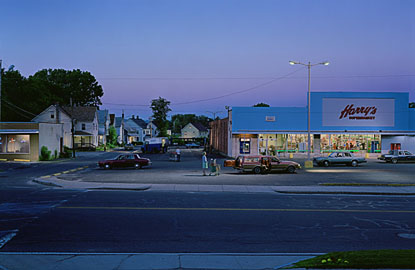
Gregory Crewdson, All rights reserved
In person the large prints are truly gorgeous. Almost all Crewdson's "stories" are set in the small towns & surrounding countryside of rural western Massachusetts & southern Vermont. It's an area I know well & have lived in. For me the shock of recognition in these pictures is almost palpable. I don't mean the specific locales but the feel -- a familiar sadness in the dusk light, the damp lushness of the summer woods, the icy bleakness of a street of white frame houses in mud season.
Let me say it again: the photographic craftsmanship in these pictures is nothing short of breathtaking (the jpegs shown here are really little better than placeholders). The pictures are a delight to look at, cloud by cloud, board by board, leaf by leaf. But they don't stop at realism. The versimilitude is supended to accentuate theatrical elements (for example, in one picture a porch light blazes across a yard & into a nighttime street like an annunciation; caught in its glare a young woman holds a suitcase as a taxi behind her gets ready to leave).
It can't be a coincidence that in three straight clipbook interviews I skimmed at the gallery Crewdson tells the same Ur story about his art. He grew up the son of a psychotherapist, he says, trained to ignore the steady stream of patients going into his father's study. But these comings & goings fascinated him; his elaborate fantasies of what went on behind those closed doors became obsessions -- which are, he claims, the source of the photographs. A little overtidy maybe, but I don't doubt it, even if the story is now mostly a reliable strategy for fending off journalists' stupid questions.
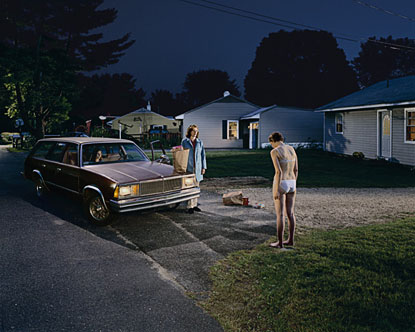
Gregory Crewdson, All rights reserved
The question is whether these obsessively remembered adolescent psychodramas are begining to wear thin as material? For me, despite their brilliance, they sometimes have an edge of levity -- & they're way too earnest to be ironic. The stories are sometimes overtold, over-obsessed perhaps. In the picture above, for instance, the dreamscape shock of adolescent humiliation is immediate & palpable -- but did the mother really have to drop the groceries in the driveway? It's too much. I get the same feeling from Crewdson's recurrently pictured theme of furtive woodland sex & post-coital tristesse -- it's too grim, too fraught -- more like Hester Prynne & the Reverend Dimmesdale in a pickup truck than an encounter people can relate to.
The gallery told me that a Crewdson print sells for 75 grand. I guess that's a pretty big incentive to keep doing what you've always done, but, then, at 46, Crewdson is still mid-career (I read that he recently exhibited very different work -- early minimalist black & white studies of fireflies -- though I didn't see it). I hope he continues to experiment. Like the mid-20th century painter Edward Hopper, one of his avowed heroes, Crewdson has a profound gift for creating (recognizing) places that take on an uncanny life. Both artists find the deep sadness (& sometimes the joy) of such places with perfectly judged emotional light. But they seem to me a little clumsy at introducing people into their made-up world.

"A woman in the sun," Edward Hopper, oil, All rights reserved
Looking at some of Crewdson's pictures -- the ones that struggle to give meaning to solitary humans staring blankly into the darkness -- I wish he would do as Hopper so often did. Let the place alone tell the story.
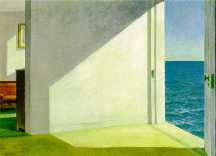
"Rooms by the sea," Edward Hopper, All rights reserved
2 comments:
Three of you who read this piece responded on flickr, where I had posted a teaser link, & one of you wrote me about it on email. I'm thankful for the response but puzzled why you didn't post here?
This has been happening since I started this blog. I'm wondering if there's some difficulty people are feeling or having with the posting process? To post I think you have to join google -- maybe not -- but anyway it's pretty straightforward. I wonder if I'm missing something.
Outstanding post, Tim! I don't know as much about photography as you do, so I love learning from you. Keep it up!
Post a Comment